Molly Penson - The Woman With A Mania For Houses
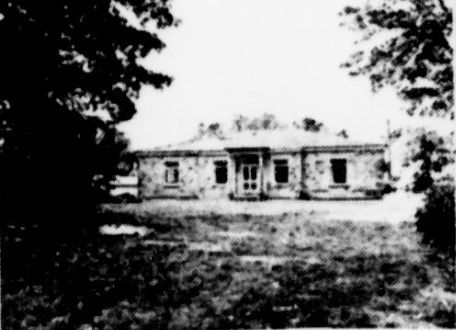
Introduction
In an era dominated by men, Molly Penson was a rare exception. After the death of her husband in 1812 she was to make a name for herself as a successful and astute business woman, her passion for property development in the early 19th century making her a very wealthy lady. A local newspaper article later described her as ‘the woman with a mania for houses’.
It was to be over a hundred years before the struggle for the emancipation of women was to bear fruit with the right to vote, and even longer before they made an impact in the business and political world. Apart from official records, it is perhaps not surprising that little is known of Molly's life, apart from the odd newspaper article or anecdote.
Wigan at the beginning of the 19th Century
By the end of the 18th century Wigan was emerging from a period of economic stagnation to become a bustling cotton and linen manufacturing town of 11,000 inhabitants. Approximately 60 per cent of all family heads were involved in textile manufacture. Forty per cent of them worked as hand-loom weavers, concentrated in the Wigan Lane and Chapel Lane areas. Only seven per cent were now occupied in traditional metal-working trades with a further seven per cent in coal mining, an industry soon to massively expand. This economic resurgence produced a house building boom in which medieval burgage plots were compulsory purchased and built over. This was particularly the case in Scholes and along Standishgate where Molly was to accumulate her considerable portfolio of property.
Molly Penson (nee Smith) (1766-1838)
Molly was born in Coppull in 1766, one of five known children to Thomas and Mary Smith, and was baptised at St. Wilfrid CE church in Standish on 1 May of that year. On 14 October 1790 twenty-four-year-old Molly married John Penson at All Saints CE Parish Church, Wigan. John was born in 1766 in Wallgate, son of James Penson, and Ann (nee Wood).
John’s father, a cotton manufacturer, had a factory located in High Street, off Wigan Lane, near the Tyldesley monument, and one in Scholes. He specialised in fustian, a thick hard-wearing twilled cloth with a short nap. The Manchester Directory shows that he was classed as a country manufacturer, trading on the Manchester Market.
On the busiest trading days of Tuesdays and Saturdays, James would travel by stagecoach to the Manchester Exchange, then onto the Spread Eagle pub in Corporation Street, Salford. Here he would stay overnight, it was his preferred base, as listed in the Manchester trade directory, where he met other traders and did most of his business, buying in supplies of cotton from the American plantations.
James became a leading member of the community, moving to Higher Woodhouses on the edge of the Beech Hill estate owned by the Member of Parliament for Wigan, Ralph Thicknesse. In later years James was listed as one of the town’s independent Burgesses, he was also a church warden at All Saints Parish Church, Wigan, and as a Bishop’s officer, served on the Parochial Council as an ex-officio member.
James Penson died in December 1800 aged 64, and was buried in the family vault in All Saints churchyard. John, as the eldest son and heir took over the running of the family business.
After their marriage Molly and John first lived in a house adjacent to his father’s factory in Scholes. Following the birth of their first child Ann they moved to 141 Standishgate, opposite the Mabs Cross monument, close to Penson’s cotton mill. It was customary at the time for owners to live as near to their factories as possible.
John and Molly lived in the large nine bed-roomed, red bricked Georgian house, for the remainder of their lives. The couple were to have seven children, all daughters. In a reflection of the mortality rates of the late 18th century when one in three children did not make it to their fifth birthday, Molly was destined to outlive them all, except one.
Ellen her fourth born daughter, died 18 December 1800 in Standishgate aged two and half, and was the first to be buried in the family plot at St. Wilfrid’s, Standish. Three months later in March 1801, Molly lost Esther, aged nearly five. Next, sometime before 1812 was Elizabeth her fifth daughter, born in 1800. Elizabeth Esther died in 1818 aged 14, and Anne her eldest, died a spinster on 18 Feb 1823 aged 31. Only two of her daughters, Mary and Ellen were to marry and produce heirs.
The Manor of Coppull
Sometime after the death of his father John Penson acquired an estate in Coppull Moor (to the west of the A49 road at Springs Brow). Later probate records name it as the Pilkington Estate.
There are references to a property on the land dating back to the 13th century. It is believed that the area was part of the four ‘bovates’ of land gifted by Richard Fitz-Thomas, Lord of Coppull, to Burscough Priory. The first mention of the Coppull family occurs in 1215, and it is probable that they were a branch of the Worthington’s of Worthington, who were said to be an ancient family in 1212. In the 13th century Coppull and Worthington were classed as one township, known as Coppull-cum-Worthington. Prior to the Reformation the Haydock family were tenants of Burscough Priory and leased land at an annual rent of three shillings.
By the mid-18th century Coppull was one of the eleven townships belonging to the ancient Parish of Standish. In 1764, two years before Molly’s birth a census was conducted by Revd E. Smalley, the Rector of St. Wilfrid’s. It showed that there were 86 families living in Coppull, with a total of 484 inhabitants.
A date stone on the barn at the property, which was Grade 2 listed in 1984, shows the date 1739. Also there were two pre-Georgian sandstone style gate posts dating from the 1500’s, and the remains of a wall, ten feet in height, also constructed from sandstone, suggesting a use for monastic purposes. John and Molly undertook a reconstruction of the house in the Georgian Palladian style which was complete about 1805.
On the 1849 Ordnance Survey map the house is shown as 'The Farm or Coppull New House'. On the census of 1851 it is listed as 'New Hall'. It was variously referred to on other documents as 'Coppull House' or 'Coppull New Hall', to distinguish it from nearby ‘Coppull Moor House’ or ‘Coppull Old Hall’, the Grade 2 listed building dating from the 1600’s, a mile and half away.

The Farm or Coppull New Hall as shown on the 1849 OS map
There are no records of John and Molly of ever having lived at the house, the 1851 census shows that cotton manufacturer, alderman and magistrate William Lamb was the tenant. William was formerly the owner of Pickley Green Colliery, which he sold in 1835. His son Jonathon was also a borough and county magistrate. He followed his father into local politics, as an alderman he represented All Saints ward in Wigan, was chairman of the public health committee, a trustee of Wigan Grammar School, member of the board of guardians and Mayor of Wigan in 1857.
The pair often sat on the bench together at Wigan Moot Hall. On 23 October 1865 they presided over the case of John Healey, who had handed himself in to police at Warwick. He confessed to being an accomplice in the infamous Button Pit (Bawkhouse Colliery) murder of watchman James Barton at Red Rock, Haigh, two years previously.
In 1867 Jonathan was appointed executor and trustee for the heiress to the Wigan Brewery, Ellen Ann Robinson Morris, whose estate was under a lunacy order. As well as their cotton interests William and Jonathan were directors of Wigan Gas Light & Gas Meter Fitting Company.
After the Lambs there then followed a succession of coal masters, colliery managers and mining engineers living at the property, right up to the decline of the mining industry in the 20th century.
By 1861 the occupants were the Darlington family, coal proprietors, and the name of the house had now been changed to ‘The Grange’. The name Grange means ‘The farm of the Monks, reinforcing the fact that this land was once part of the Burscough Priory estates.
The Grange was then taken over by Alfred Hewlett who had married Elizabeth Darlington, daughter of the previous owner James Darlington. Born in Oxford, Alfred became a mining engineer and later director and manager of Wigan Coal & Iron Co. In this capacity he was instrumental in the building of the new Wigan Mining & Technical College in Library Street, Wigan.

Alfred Hewlett (1830-1918) Mining Engineer, Wigan Coal & Iron Co.
The next tenant of the Grange was William Rogers, a director of the new Winstanley Colliery. He was a magistrate and Mayor of Wigan in 1888, the same year that he founded Coppull Prize Band.
In 1891 Pearson & Knowles Coal & Iron Co. sank two new shafts on the site of former mine workings just 500 yards from the Grange. From the colliery railway sidings, a mile long mineral line ran close to the Grange, and connected with the London & North Western Railway line just south of Coppull. The new mine was named Chisnall Hall Colliery after nearby Chisnall Hall, which was built on the site of a medieval moated manor house.

Chisnall Hall Colliery, Coppull
The Grange remained in the hands of John and Molly’s descendants up to the 1920’s when Emily Augusta Heron, the wife of her grandson Arthur Penson Heron, and their daughter Edith Mary sold it to Pearson & Knowles Coal & Iron Co. along with interests in coal seams and minerals. In 1930 Pearson & Knowles merged with Wigan Coal & Iron Co.
Sometime following nationalisation of the coal industry on 1 January 1947 the National Coal Board came into possession of the Grange, which was divided into a number of flats. The last manager of Chisnall Hall Colliery, Mr. Rutter occupied one of them.

The Grange in 1967, with Mr. Rutter, manager of Chisnall Hall Colliery in the foreground

A rear view of the Grange in 1967
Chisnall Hall Colliery became the largest coal mine in the Lancashire coalfield north of Wigan, and the last pit to be closed in the Wigan coal field in 1967. The 55 hectares site has now been returned to nature and is an award winning nature reserve.
After the closure of the mine the Grange, along with the Lodge house on Preston Road was sold into private ownership, and the two storey house reduced to a single storey with a flat roof. A later owner substantially refurbished the property and constructed a pitched roof. The outbuildings were also converted into three separate dwellings.
Property Empire in Wigan
John Penson died intestate on 17 August 1812 aged 46, leaving his widow Molly, and his four surviving daughters Ann, Mary, Elizabeth Esther, and Ellen as co-heiresses to his estate, worth up to £40,000 (9 million pounds today). John was buried in the graveyard at St. Wilfrid’s alongside three of his deceased daughters.
Molly was to take on the responsibilities of her late husband’s business affairs. On 31 December 1812 shortly after her husband’s death Molly dissolved a partnership in Princess Street Mill in Wallgate with Henry Bullock, a cotton manufacturer and dealer, and three times Mayor of Wigan.
The partnership, dated 8 February 1805, originally included her late husband John and also John Swan, who had died two years previously. That same year Henry Bullock and John Swan had taken over the mill in Scholes sold in bankruptcy by Robert Morris, the father of Thomas Morris who was to own the highly successful Wigan Brewery.
With wealth at her disposal to invest, Molly was destined to become a prominent property developer. To compete with her and the wealthy Morris, Hodson and Baldwin families, smaller developers mainly shopkeepers and tradesmen and artisans formed building clubs, in order to raise capital to purchase plots to build on in the developing property market.
Molly’s ever growing property estate stretched from High Street, off Coppull Lane, along both sides of Wigan Lane and Standishgate, down as far as the Wigan Bank in the town centre, and from there across to Long Shoot and along the Wigan to Aspull road in Scholes.
In 1828 a public footpath ran from the Golden Cross public house on Standishgate down to the two weir bridges that crossed the River Douglas, and it’s tributary that fed the factories in Water Heyes. This had the effect of dividing the Penson property, leading to problems with trespassing.
Molly's answer was to close the footpath and open a new path at the side of the Royal Oak Inn that led directly to the weir bridges, this in effect ring fenced Molly’s existing estate. The new path was named ‘New Road’. (It is there to this day connecting Standishgate to Hilton Street adjacent to the Tesco supermarket).
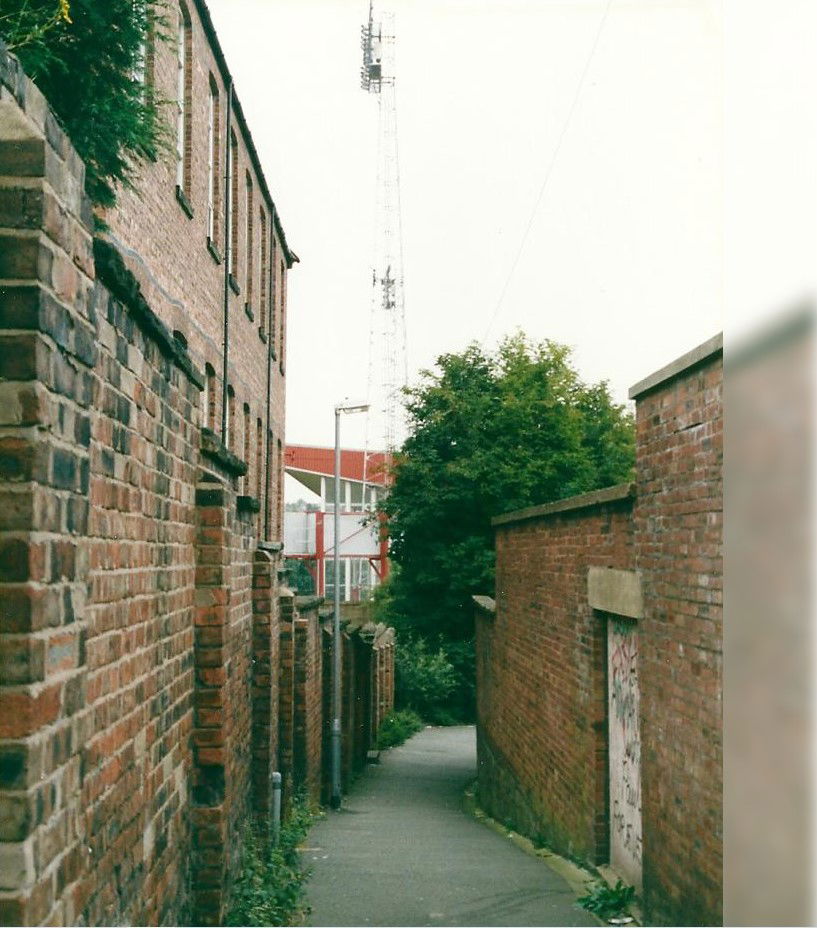
The footpath named New Road, created by Molly Penson between Standishgate and Hilton Street, at the side of the Royal Oak public house.
In total Molly owned over 200 acres of land, mainly in Coppull and Standish, two cotton mills, four farms, 69 houses, 16 cottages, six shops, three public houses, and a bowling green. Some of the identified properties include the Pilkington estate of 52 acres in Coppull, the ‘Springs’ public house and adjacent cottage in Preston Road. Also four tenanted estates with farm houses in Coppull and Standish of 20 acres, 21 acres, 23 acres, and 68 acres respectively.
Among the properties identified in Wigan was Penson's Cotton Mill in High Street, off Coppull Lane, Freckleton House in Wigan Lane and a large dwelling house just north of Duke Street. There was also Sicklefield House, the seven acre property built by Molly in 1818. It was tucked away in the Douglas Valley in Brock Mill Lane and was leased to a succession of prominent local businessmen.
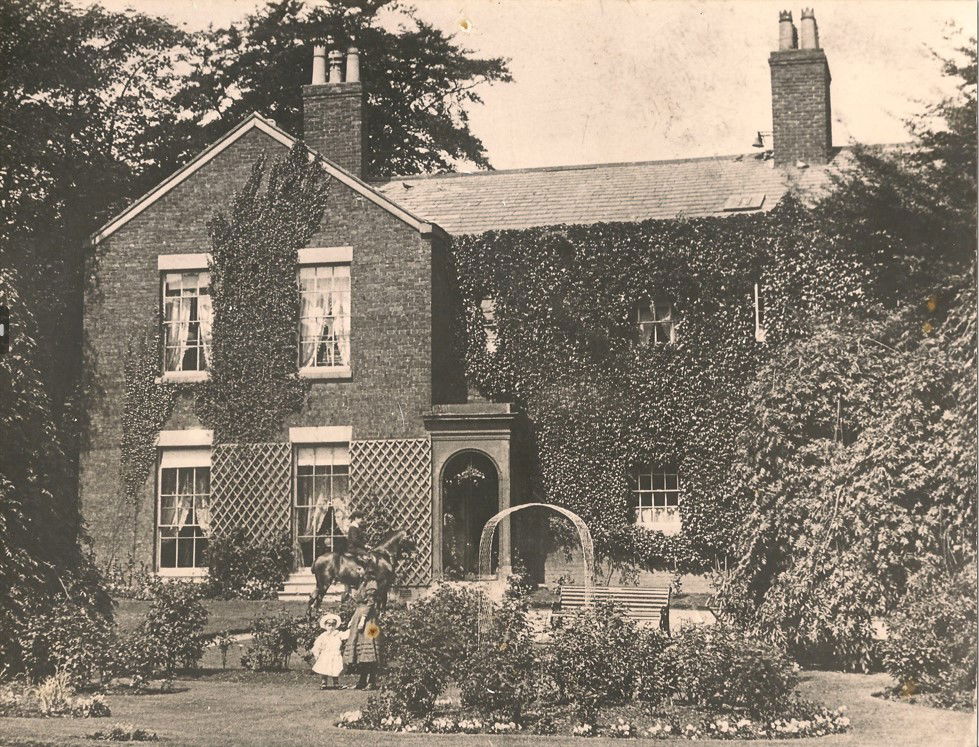
Sicklefield House, Brock Mill Lane, Wigan
In Standishgate Molly lived in seven acres of land at number 141 Standishgate, and members of her immediate family lived next door at 143. The rear of her property, which contained gardens, plantations and ponds stretched back as far as the River Douglas for which she had the rights to half of the river bed.
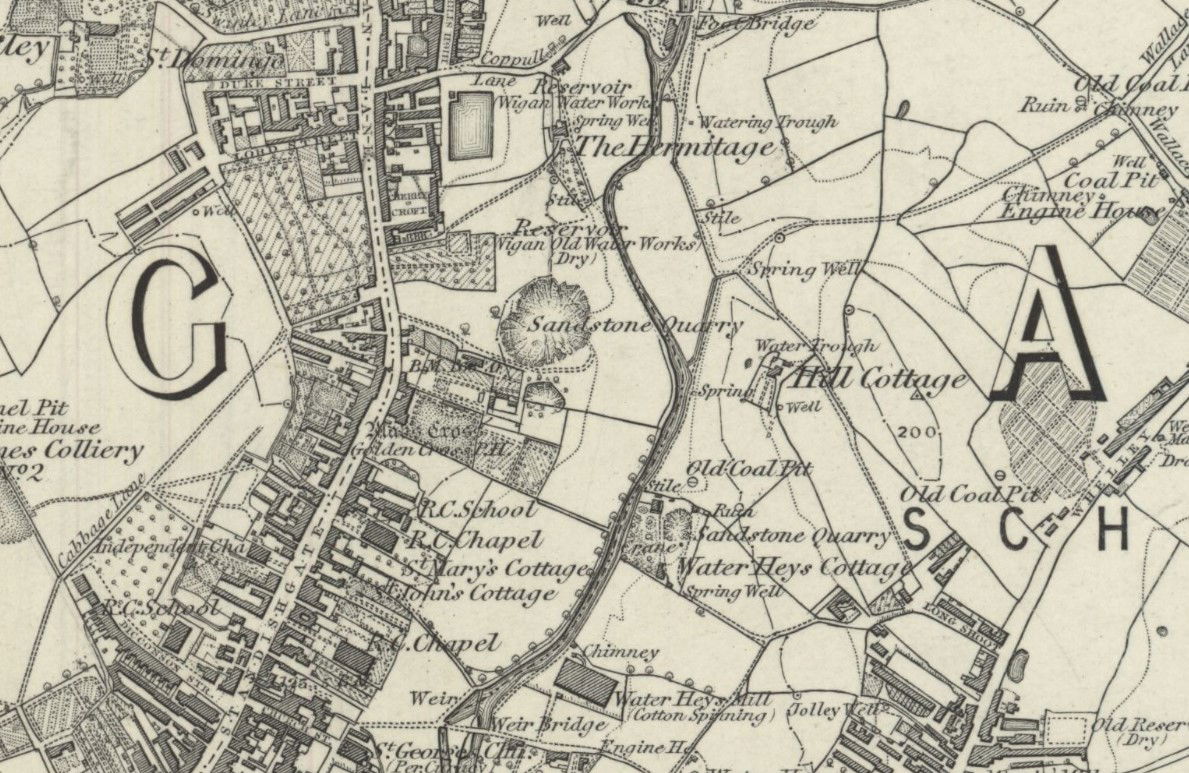
1849 OS map of Wigan Lane, Standishgate and Scholes showing Molly's house at Mabs Cross and some of the property and land that she owned
Apart from the few select detached larger houses that Molly purchased or built, most of the properties were blocks of terraced houses for mill workers or cottages for hand loom weavers. In later years some of these property developers were criticised for building sub-standard abodes that were eventually classed as slums and demolished. In the late 19th century Wigan had a reputation for some of the worst housing in the country.

Hand loom weavers cottages in Wigan Lane, on the corner of Penson Street and facing the Bowling Green Public House. They were replaced by Swinley Labour Club in later years.
Molly owned 38 houses on the east side of Wigan Lane. Two shops, two houses and ten cottages in Welsh’s Yard (later renamed Penson’s Yard), located between 125 & 127 Standishgate. The Green Man public house in Standishgate (now demolished) with three adjacent houses, and the Royal Oak Inn at 111 Standishgate with an adjoining cottage. (Built around 1820, the pub was later extended to include the next door house and was Grade 2 listed in 1983)

Green Man public house in Standishgate

Royal Oak Inn, 111 Standishgate with adjoining cottage, owned by Molly Penson
In Mesnes Lane (later to be renamed Mesnes Road) was the 2.8 acre Great Boovers Croft with cottage, and close to the town centre on the west side of Standishgate were four shops with dwelling houses and four cottages.
In Scholes was a cotton factory with reservoir, unoccupied at the time, with two adjoining houses, and two plots of land previously known as Two Crofts and Parsons Croft but renamed as Longshoot. Also she owned a third of an acre of land with coal and cannel rights on the west side of the Wigan to Aspull road. As well she had mineral rights to parcels of land (known locally as Mrs Penson’s fields) that contained valuable deposits of coal and cannel, between Standishgate and Hilton Street. These were known as the Yard Mine and the Cannel Mine.
Molly held an eighth of a share in Wigan Waterworks in Coppull Lane which provided a water supply for the town, and part shares in the associated reservoir. As befitting her social status, she also owned pews and seats in St. Wilfrid’s Church and Coppull Chapel.
Molly died 19 July 1838, aged 72, and was buried in the family plot in St. Wilfrid’s graveyard. Her Last will & testament dated 19 January 1837, and a codicil dated 10 August 1837 were proved in London on 17 October 1839. At the time of the Will her only surviving daughter was Ellen, who was a spinster.

Top part of the broken Penson family headstone in St. Wilfrid's grave yard, Standish

The bottom part of the broken Penson family headstone in St. Wilfrid's graveyard, Standish
The executors of her Will were Sir Robert Holt Leigh of Hindley Hall (now Hindley Hall Golf Club), barrister and Member of Parliament for Wigan for eighteen years from 1802. Also John Hodson Kearsley Esq of Higher Hall, Westleigh, who was Mayor of Wigan three times and Member of Parliament twice. He was the Commanding Officer of the Wigan Volunteer Light Horse which was formed in 1819, and was also a partner in the Henry Robinson brewing company. The pair were to be rewarded as beneficiaries of Molly’s estate. Her solicitor was Henry Gaskell of King Street, all three gentlemen were well-known Wigan gentry and friends of Molly. (See Wigan Election Riots 1831 and Wigan Volunteer Light Horse at www.wiganlocalhistory.org)
Apart from Molly’s real estate, her liquid assets totalled £7,000 (worth £13.75 million today). The probate for her vast real estate was so complex that it had to be administered by a special Act passed by Parliament, which determined the legalities of the extensive portfolio of estates and properties in Wigan and Coppull.
The Parliamentary Act
The Parliamentary Act dated 22 July 1847 enabled future leases, sales and partitions to be made of certain estates belonging to John and Molly Penson from that date onward. The Act, known as a ‘schedule’ was a thirty seven page document and printed by the Queens printers, George E. Eyre & William Spottiswoode.
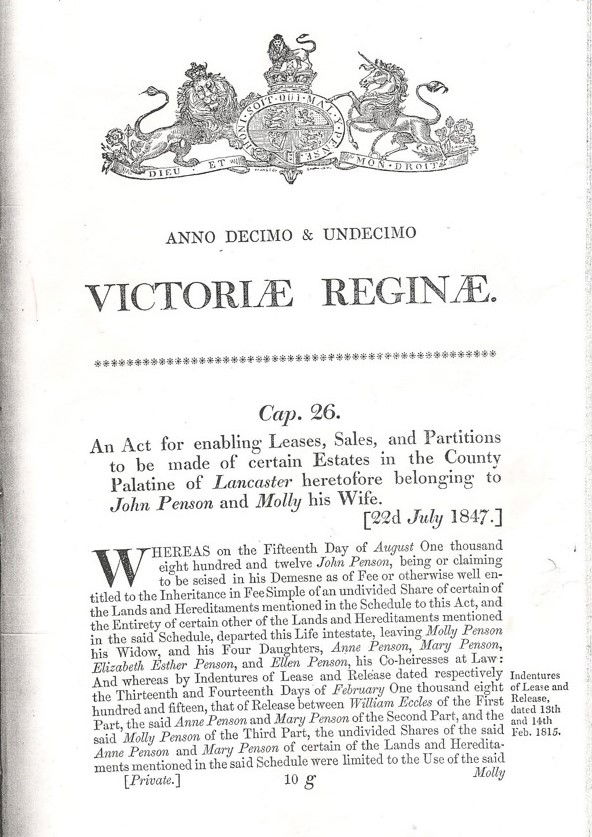
Parliamentary Act of 1847
The schedule included the details of Molly’s will and codicil, the wills of her late husband John, late daughter Ann, and of the late John Hodson Kearsley, and all Indentures of Partition, Partnerships, and Lease and Release of all properties that had been signed since the death of John Penson in 1812.
It also specified the details of the Settlements of Marriage between Mary Penson and Henry Whitaker of 2 February in 1816, Ellen Penson and Arthur Heron of 21 November 1839, and Mary Whitaker (daughter of Mary Penson) and William George Maude of 1 August 1843.
Listed were the names of Trustees as they changed over time. Sir Robert Holt Leigh and John Hodson Kearsley Esq were replaced by Henry Gaskell and Henry Whitaker respectively by the Indenture of 29 October 1839. These latter were replaced on 18 March 1847, Henry Gaskell by Arthur Heron and Henry Whitaker by his son Henry Whitaker Jnr. These two were replaced by Mary Braithwaite of Bolton le Moors, and Henry Lomax Gaskell of Wigan, son of Molly’s one time solicitor and trustee Henry Gaskell.
The schedule confirmed the inheritance trail for Molly’s co-heiresses, her three daughters who had predeceased her. Elizabeth Esther Penson died intestate on 2 January 1818, leaving her three sisters Ann, Mary and Ellen as co-heiresses. Ann Penson made her Will on 28 November 1822, leaving her undivided share to Molly, with ‘Power of Appointment’ to Mary and Ellen should they be living at the time of her death. If her sister’s predeceased her then their heirs and assigns would inherit. Ann died 23 March 1823 leaving her two sisters as co-heiresses. Mary (Whitaker) died 29 October 1836, under the terms of her marriage settlement of 1816 her heirs would now inherit her share.
An indenture of Release signed 10 October 1840 instructed the executors Sir Robert Holt Leigh and John Hodson Kearsley Esq to raise £6,000 with interest (worth £13.5 million today) on her Coppull and Standish property as a Trust Fund for her only surviving daughter Ellen, and her heirs and assigns if she married. The executors were rewarded with land and property being transferred to their names.

Indenture of Release 10 Oct 1840
The Schedule confirmed Molly’s Will and Codicil and specified how her estate was to be divided among her descendants in equal shares of inheritance ‘Per Stirpes’. (An estate planning method in a will or trust to specify that if one of your beneficiaries dies before you do, their share of your estate is divided equally among the deceased beneficiary's descendants).
The schedule named seventeen beneficiaries to Molly’s Estate. Her daughter Ellen Heron, son in law Arthur Heron, grandson Arthur Penson Heron, and son in law Henry Whitaker, the husband of her late daughter Mary.
Grandchildren John Penson Whitaker, Henry Whitaker Jnr, William Whitaker, Ann Whitaker, Edwin Whitaker, Robert Whitaker, Elizabeth Whitaker, Helen Whitaker, Frances Whitaker, Mary Maude (nee Whitaker), her husband William George Maud. And lastly great grandchildren Henry Maude and Frederica Amabel Whitaker.
The act also instructed that all monies gained from the sales of property or land and from leases for mining purposes be first paid into an account at the Bank of England.
Molly’s Descendants
Mary Penson
Mary, Molly’s second daughter was born 14 February 1794 in Standishgate, and baptised a month later at All Saints parish church. She married Henry Whitaker, a general broker from Liverpool, at Wigan Parish church on 22 February 1816. Henry was a native of Bingley, West Yorkshire, where his father John was a staff maker.

Painting of 16 years old Mary Penson (1794-1836)
After their marriage Henry and Mary settled in St. Annes Street in Liverpool, where they had eleven children, six boys, and five girls.
Mary died 29 October 1836, aged 42, shortly after the birth of her youngest child Frances, who was baptised the day following her mother's death. Earlier that year she had lost her 19 month old son George Arthur. Mary was buried 3 November at St. George CE church in Everton. Henry died in 1851 aged 72 and was buried on 6 December alongside his wife.
Of their sons, John the eldest and William the third son went into partnership with their father as general brokers, trading as Henry Whitaker Son & Co. Their offices were at 13 Rumford Street, Liverpool, in the docks area near the Royal Liver Building.
Henry Jnr, Mary and Henry’s second son moved to Wigan and took possession of 143 Standishgate, next door to Molly’s old house. Molly’s will had ensured that members of both her daughters families would live in the two houses in Standishgate. With his brother in law and next door neighbour Arthur Heron, Henry looked after the Penson cotton spinning interests. On 20 April 1847 Henry married a Wigan girl, Eleanor Eccles at Wigan Parish church.
The couple had six children, five boys and a girl, all born at 143 Standishgate but sadly a son, Richard died in 1857 aged three, he was buried in Wigan Cemetery, Lower Ince, plot C, grave 528. Henry Snr died 15 May 1874 aged 55.
Around 1884 Eleanor left Wigan to live at Hoscote Park in West Kirby on the Wirral, along with four of her children, William, Mary, Thomas, and Anthony who were all unmarried. William died in Chester in 1879 and Henry Jnr in West Kirby in 1886. Her eldest son, also Henry stayed on in Wigan and lived in Park Crescent, where he died a bachelor in 1886. All three were buried in Wigan in the family plot
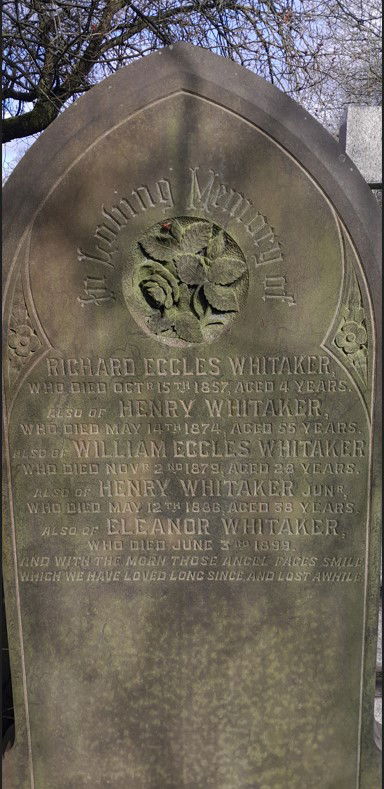
The Whitaker plot at Wigan Cemetery, Lower Ince, containing the burials of Henry Whitaker Snr, his wife Eleanor (nee Eccles) and their children Richard, Henry Jnr and William.
Edwin, son number four worked in property dividends in Liverpool. He married and moved to Ayrshire where died in 1908.
Robert, Henry and Mary's fifth born son emigrated to America and settled near Minneapolis in the State of Minnesota, where he found employment as a hotel clerk. On 22 September 1864, aged 37 and at the height of the American Civil War he enlisted into ‘A’ Company, 1st Regiment, Minnesota Heavy Artillery, part of the Union army. The conflict ended 9 April 1865 and Robert survived unscathed. He was discharged with the rank of corporal three months later in July 1865.

Robert Whitaker (1827-1888) 2nd right with Civil War veterans from White Bear Lake, Minnesota
On 4 September 1868 Robert married English girl Mary Nixon, she had emigrated from Appleby-in-Westmoreland in 1857. After settling in White Bear Lake they were to have 15 children. The US city directory of 1882 shows that Robert was a clerk in the Ramsey County Recorder’s office. Robert died 30 April 1888 aged 61.
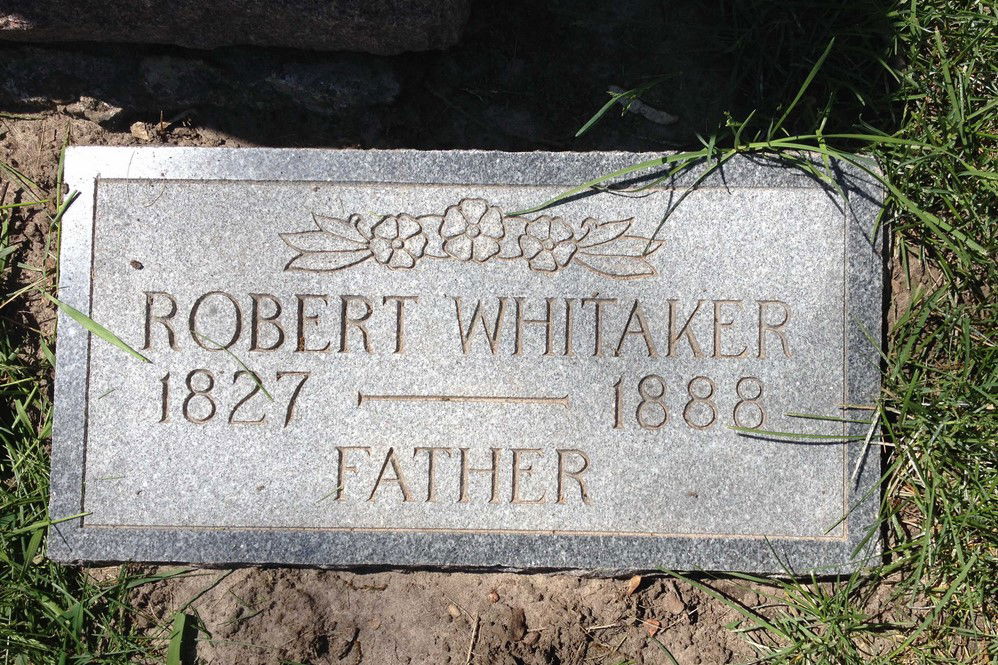
Robert Whitaker's headstone provided by the US Government for Civil War veterans.
Of Henry and Mary's daughters Mary, Ann, and Elizabeth married and moved to Yorkshire where they lived for the remainder of their lives. Elizabeth to an ex army officer, Major John George Muller, He was born in Frankfurt-am-Maine in Germany to an English mother and German father and was now a British Subject. Anne married but remained in Liverpool where she died in 1879. Helen Penson Whitaker moved to 141 Standishgate in Wigan to be companion to her aunt Ellen following the death of her uncle Arthur Heron in 1870. Her older brother Henry Jnr lived next door at 143. Helen remained a spinster and died in Shropshire in 1902.
Ellen Penson
Ellen, Molly’s youngest daughter was born on 2 September 1808 at 141 Standishgate. On 9 November 1839, the year following her mother’s death she married Arthur Heron, whose family lived in Manchester, at Wigan parish church.
Sometime before 1834 Arthur and his brother John Spier Heron, along with his wife Sarah and daughter Elizabeth moved to Wigan and took over Sovereign Mills in Warrington Lane, which the Penson family had once owned. They all lived in a large house in the grounds of the mill known as Sovereign Cottage. The Electoral Rolls show that Arthur also owned freehold houses in Crosby Green and Patricroft and a third share in three houses in Dog Lane, Upholland.
In 1835 the Borough of Wigan was included in what was known as a ‘Schedule 'A' Borough’ with a Commission of the Peace. The style of the corporate body was ‘Mayor, Aldermen, and Burgesses of the Borough of Wigan’. John Spier Heron was elected the first Mayor of Wigan under this act on 1 January 1836. In 1841 Sovereign Mills failed and went into liquidation with massive liabilities, hundreds of workers lost their jobs causing much hardship to the local community.
That year the brothers were also cited in another bankruptcy case, as co-partners in the cotton trade in Manchester with their father James Holt Heron, who owned a mill in Chapel en- le- Frith in Derbyshire, and their brother James Knight Heron. The quartet were declared bankrupt but by 1845 all debts had been paid off and the bankruptcy was annulled.
After the closure of Sovereign Mills and the bankruptcy case in 1841 John moved his family to Bowdon, near Altrincham in Cheshire. Here a fourth child was born, also named John Spier Heron, he went onto become a prominent engineer in Manchester.
Arthur was protected financially from his family's financial problems by his marriage to Ellen Penson and continued in the cotton trade. He died 11 February 1870 aged 59 and was buried in St. Wilfrid’s graveyard. This left Ellen as the matriarch of the family, in the same circumstances that her mother Molly had faced 58 years before on the death of her father. Her unmarried niece, Helen Penson Whitaker moved from her family home next door to be her companion.
Ellen died 8 Feb 1876 aged 67 at 141 Standishgate, the house where she had been born and lived in all her life. Ellen and Arthur’s only child Arthur Penson Heron was born in early 1840 and baptised at Wigan Parish Church on 4 March. The 1861 census finds him living at Highfield House, Nunnington, North Yorkshire. It was the home of Thomas Stamper who farmed 472 acres and was teaching Arthur how to be a farmer.
Two years later Arthur married Emily Augusta Forde, a vicars daughter who was born in Beverton, near Tetbury in Gloucestershire. Her father Revd Frederick Forde performed the ceremony at his church, St. Peter’s in Chester.
Sometime after their marriage Arthur moved to Chorley where he leased the 153 acre Farnworth House and farm from William Standish, owner of the Duxbury Estate. Here sons Francis, in 1864, and John in 1867 were born. In 1869 their daughter Evelyn was born at their second home in Huyton
In 1870 following the death of his father Arthur decided to give up farming at Duxbury. On 8 August of that year he advertised all his produce of oats, wheat, and potatoes for sale. Three months later he sold his livestock of eight horses, two bulls, 16 cows, 38 sheep and 23 pigs.
The following years census of 1871 lists him as an annuitant living off his own means in Huyton. A move then followed back to 141 Standishgate in Wigan where his youngest child Reginald was born in 1878.
On 19 July of the following year Arthur placed an advertisement in the Wigan Observer advertising 141 Standishgate for let. The property comprised three reception rooms, domestic offices, nine bedrooms, dressing room, box room, kitchen, and wash houses. Externally was a garden, paddock, three stalled stables with yard, harness room, and carriage shed.
On 16 August 1879 he advertised his horse for sale, a dark chestnut cob, six years old and nearly 14 hands for the price of £35. Arthur then left Wigan for good and the 1881 census finds him living in Dorking, Surrey, with his wife and three youngest children. Further moves followed to Eastbourne in Sussex and then Guildford in Surrey. Arthur died in St. Albans, Hertfordshire in 1910.
Wigan in the 1870’s
The decade between 1870 and 1880 was a time of momentous change for Wigan when the town expanded rapidly and was to undergo a period of prosperity.
In 1868 Wigan Town Council had passed a resolution by councillors Gregson and Gilbert to acquire a site for a new market hall for the town with a large square at its frontage. The two councillors acquired the Commercial Hall site from Sir Francis Sharp Powell the ex-Wigan MP, whose father was incumbent of St. Georges Church. However the ambitious plans meant that a large amount of land on ‘The Mesnes’ would also be required from the Rector of Wigan, the Hon. George T.O. Bridgeman.
The Rector generously gifted the land on the following conditions: there would be new roads built around the market that gave entry to it from all sides, there would be access to Frog Lane and Hallgate, the market square would not be enclosed within a wall or fence, and a new road would be made into the Mesnes to the north of Hope Street at least 15 yards wide.
They found that to meet these conditions they would need a piece of land that belonged to Molly Penson’s heirs (this presumably is the 1.8 acres of land called Boovers Croft mentioned earlier in the government schedule). However the price asked for it, was found to be too excessive. At the same time another of the property owners refused to let a street be put through his land. Despite the Rector agreeing to give extra land, the scheme fell through and was put on the shelf.
In 1871 Nathaniel Eckersley of Standish Hall, the influential cotton master, banker, and ex Member of Parliament for Wigan revived the Market scheme. The required land was purchased and the covered market hall measuring 200 feet by 150 feet in front of the market square, and the adjoining fish market of 120 feet by 50 feet was finally opened in on 21 May 1877 by the Mayor of Wigan, Walter Mayhew.
The town’s other major projects were completed. Wigan Infirmary was officially opened by the Prince and Princess of Wales in 1873. Mesnes Park was opened in 1878 along with the Free Library in Rodney Street, and Wigan Grammar School in Parson’s Walk opened in 1879.
In 1877 the Streets, Buildings and Improvement Committee rejected plans that had been submitted by Molly Penson’s Trustees for a new street to be laid out on land between Wigan Lane and High Street. The plans were eventually passed at a later date and the new street was named Penson Street.

Molly’s Old House
In 1879 after Arthur Penson Heron had left Wigan, the lease on 141 Standishgate was taken up by a widowed Scotswoman Annie Elizabeth Copeland who ran a drapery business. Four years later in 1883, it was opened as a private boarding school for boys, the patron was Mr. Woods of St. Andrews University in Scotland. Three years later 143 Standishgate was opened as a private girls high school. The school master was 57 years old Anthony Craston who hailed from Westhoughton.
On Friday 18 May 1893 an auction was held at the Victoria Hotel in Wallgate. For sale were ten lots of freehold property in Wigan Lane, Standishgate, and Scholes belonging to the Penson family. These included the Penson family homes of 141 and 143 Standishgate, the Royal Oak and Green Man public houses, and plots of land containing coal and cannel in Longshoot, Hilton Street and Standishgate. All the lots except one were withdrawn, this was ground rent for a plot of land and dwelling houses in Longshoot which sold for £275.
The last resident of Molly Penson’s old house was Henry Brierley, Chairman of the Wigan Higher Education Sub-Committee. In May 1905 Wigan Education Authority assumed complete responsibility for the Church High School for Girls.
The next year they purchased 141 and 143 Standishgate, known locally as ‘Heron’s Houses’, in one and half acres of freehold land, for £3,000 (worth £457,000 today). The properties were taken over by the Girls High School who moved from 19 New Market Street, where they had been since 1887. The premises proved too small so a temporary structure known as the ‘Tin Tabernacle’ was built behind the school, which the girls moved into in the autumn of 1907.
By 1912 the two old buildings had been demolished and an architect was appointed to make plans for a new school to replace the Tin Tabernacle. However the start of the Great War in August 1914 inevitably led to delays, and the foundation stone wasn’t laid until 3 March 1915.
The new school, to be known as Wigan Girls High School, finally opened its doors eighteen months later on 23 September 1916. In 1918 Wigan Education Authority purchased Woodfield House in Wigan Lane to accommodate the younger girls under the age of eleven years.

Wigan Girls High School (pre1921), built on the site of the Penson home and showing the Mabs Cross monument in it's original position.
In August 1921, owing to a road widening scheme the Mabs Cross monument was moved from its original position on the west side of Standishgate over the road into the grounds of the High School.
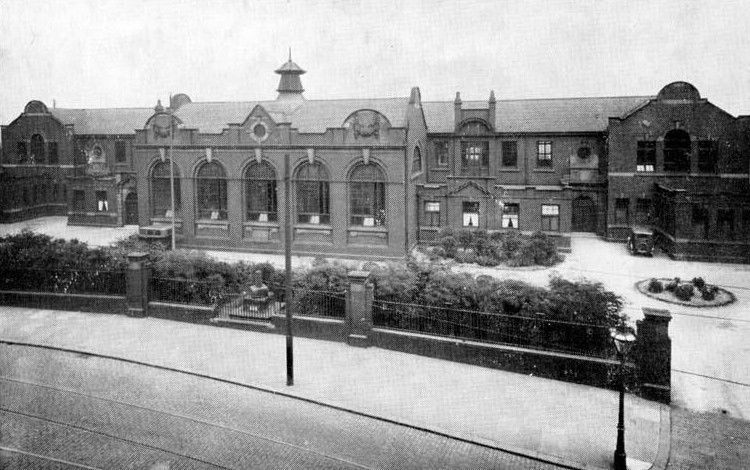
Wigan Girls High School, Standishgate (post 1921) with Mabs Cross in new location
In 1973 Wigan Girls High School moved to new premises in Whitley Crescent, becoming a mixed comprehensive school, it was to have a short life, closing in 1990. Today Mabs Cross Primary School occupies the old Girls High School site in Standishgate.
Today none of Molly’s descendants live in the town, they are spread far and wide, home and abroad. The only visible reminder to her property empire is Penson Street, located between High Street, where the old Penson cotton factory once stood, and Wigan Lane.
Graham Taylor 2024
Acknowledgements
Many thanks to Christine Barbour-Moore for providing access to her many years of research on Molly Penson and Coppull.
Sources
A History of Coppull by Hubert Walsh 1878
Ancestry Boyd’s Marriage Index 1538-1850
British History Online
Duchy of Lancaster Records
Duxbury in Decline-The Fortunes of a Landed Estate 1756-1932
Find My Past
Google Maps
Lancashire Archives
Lewis Directory of Manchester & Salford 1788
Lancashire Online Parish Clerks Lancashire Births, Marriages, & Deaths
Lewis’s Directory of Manchester & Salford 1877
National Archives
National Library of Scotland Maps
Nineteenth Century Housing in St. Helens and Wigan – John J.T .Jackson BA PhD Wigan
Archaeological Society
Wigan & Leigh Archives Online
Wigan Local Studies
Wigan Local History & Heritage Society
Ron Hunt of Wigan World
Wikipedia